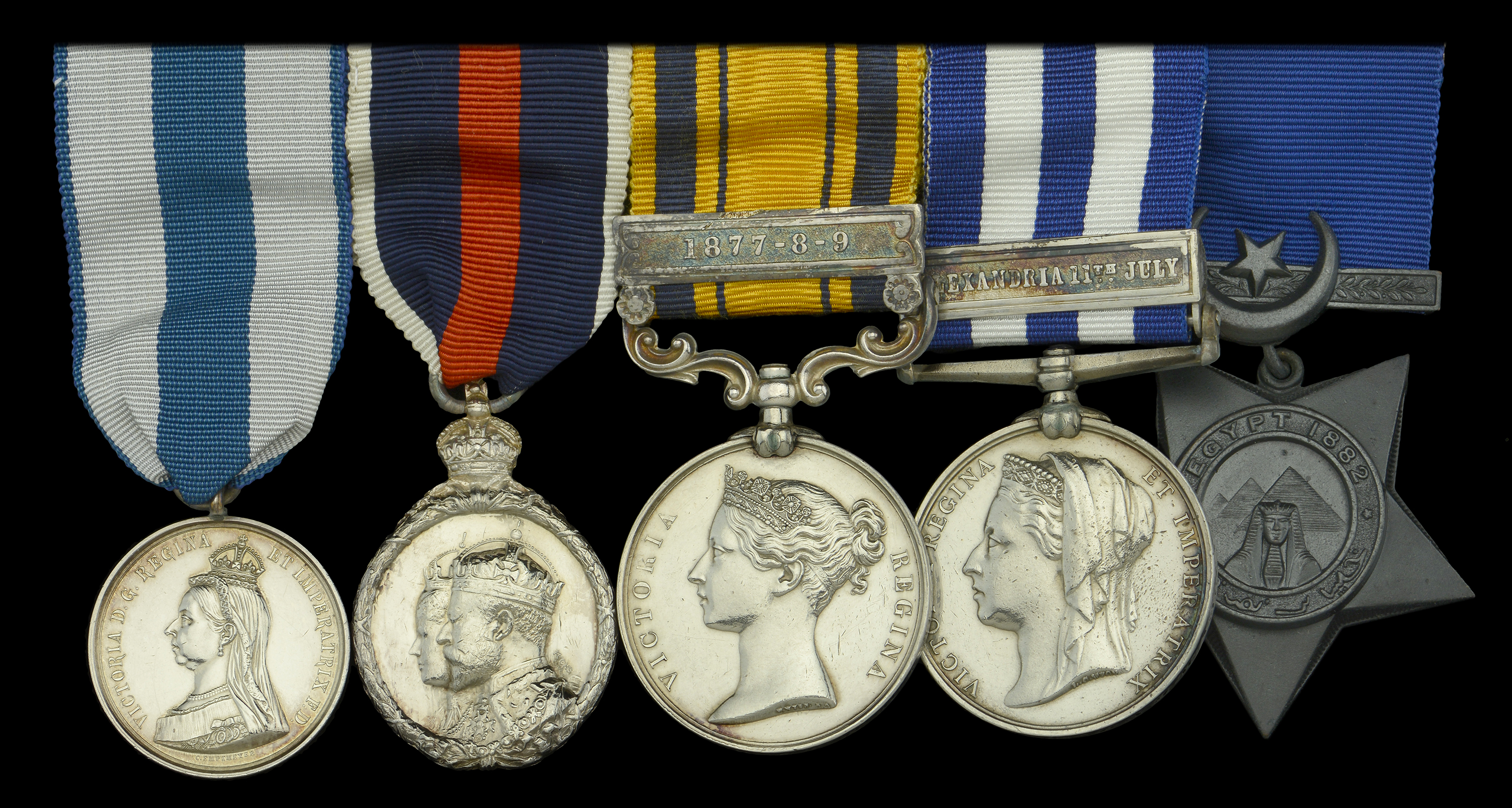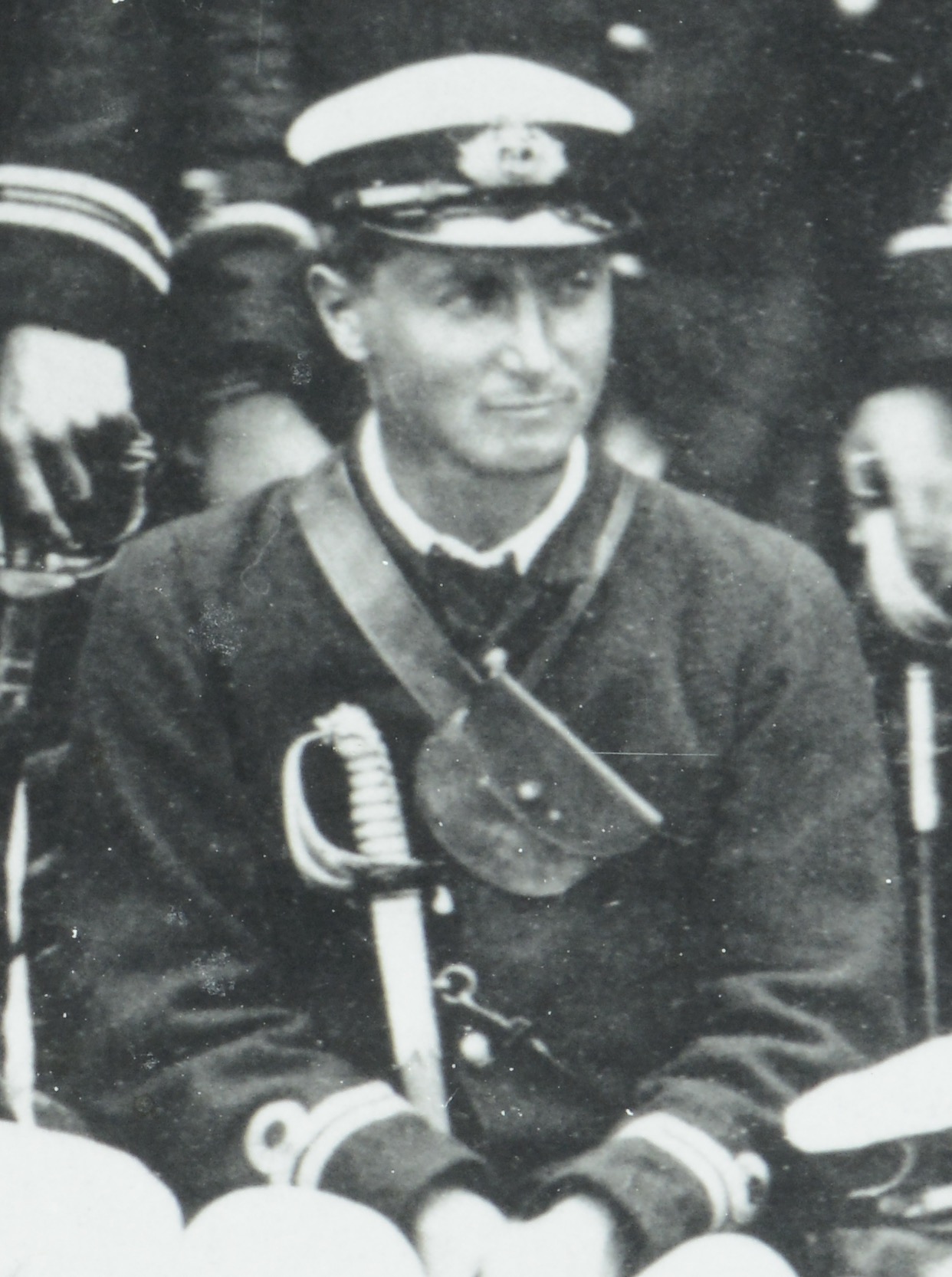‘We have killed several snakes lately, one, a black mamba, a most deadly creature, we found close to the tents; he was eight feet long. I have a horror of snakes; a small one ran over my foot at breakfast a few days ago. I killed him afterwards, when the doctor made an examination, and pronounced him harmless. Walking in long grass about here, one must always wear leggings … ’ Just one aspect of a bluejacket’s life on the campaign trail in South Africa, as recounted in a letter home by William des Vaux Hamilton on 18 December 1878. The rare and outstanding South Africa 1877-79 and Egypt 1882 operations campaign group of five awarded to Vice-Admiral W. des V. Hamilton, Royal Navy, who was twice mentioned in despatches for his protracted service in H.M.S. Active’s Naval Brigade in South Africa; fortuitously for posterity’s sake, he was a gifted correspondent, descriptions of the actions fought at Quintana in February 1878 and Inyezane in January 1879 being but two fascinating accounts to appear in his privately published Letters from Kaffraria and Zululand, 1877-78-79 Jubilee 1897, silver, unnamed; Coronation 1902, silver, unnamed; South Africa 1877-79, 1 clasp, 1877-8-9 (Lieut: W. des V. Hamilton, H.M.S. “Active”); Egypt and Sudan 1882-89, dated reverse, 1 clasp, Alexandria 11th July (Lieut: W. des V. Hamilton. R.N. H.M.S. “Alexandra.”); Khedive’s Star, dated 1882, some very light contact marks and pitting from star, otherwise nearly extremely fine (5) £4,000-£5,000 --- Importation Duty This lot is subject to importation duty of 5% on the hammer price unless exported outside the UK --- --- Just seven South Africa Medals with ‘1877-8-9’ clasps were awarded to R.N. officers. William des Vaux Hamilton was born on 17 September 1852, and entered the Royal Navy as a Cadet in Britannia in April 1866. Appointed a Midshipman in June 1868 and advanced to Sub Lieutenant in September 1872, he lent valuable service in H.M.S. Vulture in connection with the suppression of the slave trade in East African waters in 1874-75. Thanked by the Admiralty for the ‘zeal he displayed’ in the capture of a slave dhow, he was specially promoted to Lieutenant. Having then joined the Active in July 1877, he was landed as second-in-command of her bluejackets for operations against the Gaikas, his introduction to the local climate taking its toll: ‘Weather very hot; my face is the colour of the dining-room curtains after they were dyed, and my nose is in a dreadful state.’ Oppressive heat aside, Hamilton was present in several skirmishes in Transkei, as well as the more important action at Quintana on 9 February 1878, when he commanded the rocket party: ‘My party of bluejackets, and the rocket apparatus, were sent away to a hill on the right, where I was told to cover the advance of the Fingoes … to get there they had to ascend a steep incline, directly in front of where my party were extended in skirmishing order. When about half way up the incline, the Kaffirs opened fire from behind a ridge, where they lay concealed, and over which the Fingoes must pass to get into the bush behind. Our allies object very much to being shot at, and looked very like retiring, when I got a message from Captain Upcher to advance and support them. Away we went, leaving our rocket apparatus behind … the firing from the ridge was pretty brisk … we could not do much in the way of returning fire, as we only saw a black head bob up for an instant amongst the long grass and other good cover they were in. When about thirty yards from the top, we doubled up at them, and away they bolted into the bushes, and out of sight in an instant … the casualties on our side were one bluejacket severely wounded in the foot – when we were advancing up the hill – and four Fingoes wounded. The bluejacket is doing very well and has been since sent down to hospital at King William’s Town … ’ Hamilton’s letter home from Ibeka, dated 17 February 1878, added: ‘Captain Upcher was good enough to make a favourable report of our little exploit, and you will be glad to hear I am mentioned in despatches … ’ Subsequently, in the Zulu War, he commanded a company of the Naval Brigade at the battle of Inyezane, where he and his bluejackets charged the Zulu positions. His letter home from Eshowe, dated 24 January 1879, takes up the story: ‘The Zulus had chosen and excellent position to attack us. At every side we were surrounded by high hills, covered with brushwood, and in a moment they opened fire on us from all quarters. Their object was, I suppose, to cut off the waggons, and our immense line prevented any reinforcements being brought up … The Zulus were all around us, and finding it impossible to do much where we were, we moved to the rear and extended along the road. A kraal on the left of the road was at first occupied by the Zulus, but before we came up it was taken by two companies of the natives under Captain Hart, our rocket party having sent a rocket right through the place first. Along the road we were exposed to fire from both sides, as the high ground on one each side was occupied by the enemy. Whilst there, I had five men wounded in my company, two very severely. As there appeared no chance of our fire driving the Zulus from their position, we kept advancing with a view to charging the ridge and forcing them to retire. Before doing so we were reinforced by one company of the Buffs, under Colonel Parnel, and Captain Hart’s natives. Captain Hart was most anxious to advance at once; he and Captain Campbell finally rode on, almost alone. I followed, bringing up my company as fast as I could, followed by the Buffs. Two of the Buffs were killed there, and Colonel Parnel’s horse was shot under him; our other company of bluejackets was some distance behind. The Zulus did not wait for us; they bolted to a man, and we advanced and took the heights without any further resistance … ’ Afterwards, as part of Colonel Pearson’s column, Hamilton and his bluejackets joined the garrison at Eshowe. And by way of closing a period of 18 months ashore, they served in General Crealock’s column in the advance on Port Durnford. He was again mentioned in despatches (London Gazette 5 March 1879, refers). In October 1880, Hamilton joined the Alexandra, in which capacity he witnessed further action at the bombardment of Alexandria in July 1882, in addition to serving in the Naval Brigade at the occupation of Port Said. During this period ashore, he was employed destroying railway lines with gun-cotton and was strongly recommended by Admiral Sir B Seymour. Later in 1882, he was appointed to the royal yacht Victoria & Albert and on leaving her in September 1883, he received promotion to Commander. A succession of senior appointments ensued, among them Flag Commander on the Australian Station from 1884 to 1889, and Captain of the North American Station from 1892 to 1895. Hamilton was subsequently appointed Chief of Staff to Admiral Sir John Hopkins K.C.B., Commander in Chief on the Mediterranean Station, in which capacity he received the Jubilee Medal in 1897 and, as an A.D.C. to King Edward VII, the Coronation Medal in 1902. His next appointment was as second-in-command of the Mediterranean Fleet, but his health deteriorated due to an attack of fever, as a result of which he was invalided to England. His advancement to Vice-Admiral was announced just two days before his death in February 1907. As cited above, his extensive correspondence from South Africa was ...









